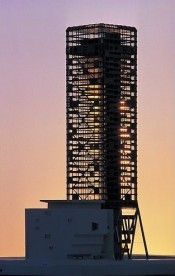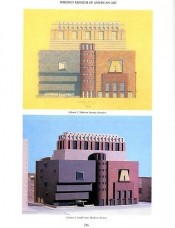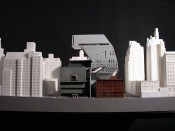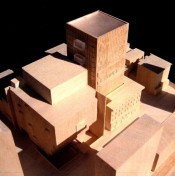What's Next for the Whitney
Love it or hate it, Marcel Breuer's granite-clad Whitney Museum of American Art has loomed over 75th Street and Madison Avenue in New York's Upper East Side for over 40 years. After repeated attempts to expand and add much needed gallery space, the Whitney has officially announced it is headed downtown. Renzo Piano designed a new building for the Whitney in the hip Meatpacking District adjacent to the High Line, an abandoned, elevated railway that has been converted into a highly publicized park.
 Courtesy whitney.org, photograph by Jerry L. Thompson
Courtesy whitney.org, photograph by Jerry L. Thompson
Although the move marks a step forward for the Whitney, what will become of Breuer's iconic Brutalist design? We take a look back at the building's controversy-filled past and ponder the possibilities for its future.
Proposed (and Faltered) Additions
Expansion Timeline
Foster + Partners 1978 expansion concept Detail of Graves's 1987 (second) Scheme A 2003 proposal by Rem Koolhaas Renzo Piano's 2005 proposalThe Whitney has tried—and failed—to expand five times in 25 years, each effort either shot down by the members of the conservative Upper East Side's Community Board 8 and city officials or scrapped due to cost constraints and the indecisiveness of the Whitney's board. Foster + Partners prepared an unofficial expansion plan for the Whitney in 1978, including a modern glass and steel cross-braced condominium tower on behalf of an Italian developer. In the mid-1980s, Michael Graves developed a Post-Modern flavored proposal, controversial for its blocky, Classicist forms and bold use of color. After it was soundly rejected by the neighborhood, he tweaked the scheme twice to make it more restrained, only to face rejection yet again.
In 2003, the Whitney engaged avant-garde architect Rem Koolhaas to take another stab. This design was much more daring than any of Graves's, featuring a large concrete tower with lacy windows that would rise from neighboring historic brownstones and cantilever over the existing building. Though this design was praised by other architects, the Whitney abandoned it, citing cost as the reason. Two years later, Renzo Piano came on board, and he proposed a polite, nine-story glass addition that would subtly connect with Breuer's building through a series of glass bridges. This design was eventually approved by the city, just in time for the Whitney's Board to determine that a new building was far more feasible—both spatially and financially—than expanding the existing one.
The New Whitney
Piano was retained to design the Whitney's new home: a six-story, 195,000 square foot building with a $680 million price tag, to be located near the south entrance to the High Line in Manhattan's Meatpacking district—home of the new Standard Hotel and Diane von Furstenberg's headquarters. "Downtown is a new city, a new nation. Why shouldn’t the Whitney be the museum of record there?” said Leonard Lauder, Estée Lauder cosmetics heir and the Whitney’s chairman emeritus and largest benefactor, in an interview with the New York Times. The move downtown is a homecoming of sorts, as the Whitney originally opened in Greenwich Village in 1931.
 Concept sketch for new building by Renzo Piano
Concept sketch for new building by Renzo PianoReminiscent of Breuer's design, the new Whitney will face the city with solidity: Piano clad his design in stone, though it may be value-engineered to metal panels. Other throwbacks include its cantilevered entrance and stepped form, which will likely receive a warmer reception in this trendy neighborhood, with its somewhat industrial vibe. The program features rooftop exhibition space and large interior galleries uninterrupted by columns, nearly doubling the Whitney's current gallery space. The project will break ground in less than a year and is scheduled to be completed by 2015.
 The new Whitney: a rendering of Renzo Piano's downtown design
The new Whitney: a rendering of Renzo Piano's downtown design
What's Next for Breuer's Building?
The Whitney's Board agrees that the museum can't realistically run two locations, although there are a few models for multiple-site museums including the Tate in London and the Museum of Contemporary Art in Los Angeles. Instead, it is toying with the idea of leasing the Breuer building to its neighbor six blocks away, the Metropolitan Museum of Art. This setup would not only benefit the Whitney financially but would provide an opportunity for the Met, which is locked in on three sides by Central Park and thus faces its own expansion challenges to housing its contemporary and modern art collection during renovations.
One thing is for certain: Breuer's building won't be demolished or significantly altered, thanks to its status as a landmarked building located within the Upper East Side Historic District. It's also safe from such fates as conversion to luxury condos, because the Landmarks Preservation Commission stipulates that it must remain a museum, albeit a museum that will never expand: the Whitney's board has decided to sell adjacent properties including an annex building and a row of brownstones.
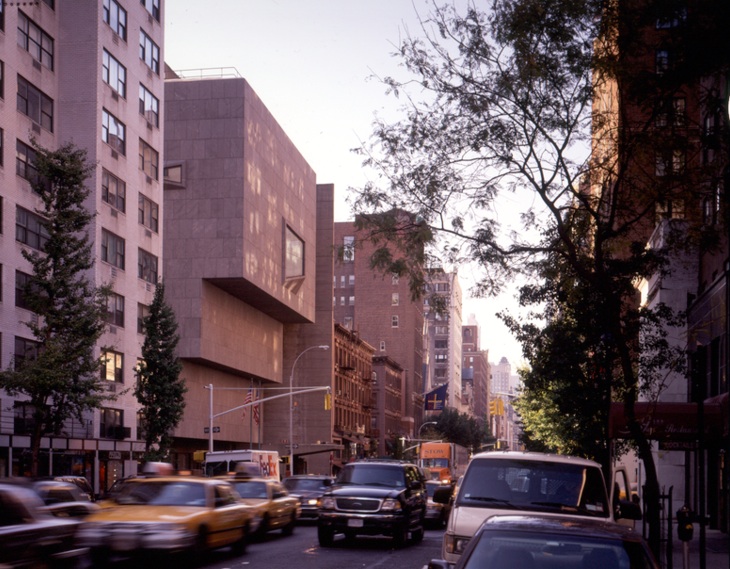

Murrye Bernard
Murrye is a freelance writer based in New York City. She holds a Bachelor's degree in Architecture from the University of Arkansas and is a LEED-accredited professional. Her work has been published in Architectural Record, Eco-Structure, and Architectural Lighting, among others. She also serves as a contributing editor for the American Institute of Architects' New York Chapter publication, eOculus.
Website: www.murrye.com
